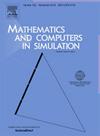Vegetation-water system with positive feedback: Effects of local versus nonlocal grazing
IF 4.4
2区 数学
Q1 COMPUTER SCIENCE, INTERDISCIPLINARY APPLICATIONS
引用次数: 0
Abstract
Positive feedback plays a crucial role in maintaining ecosystem stability and preventing desertification in semi-arid regions. However, researches on the evaporation suppression as part of this positive feedback remain limited. To deeply explore the influence of positive feedback effect on the stability of positive equilibrium point in local and nonlocal grazing systems, we propose and investigate a nonlocal grazing vegetation water model system with saturated evaporation suppression effect and soil water diffusion intensity. The eigenvalue method is used to analyze the stability of the positive equilibrium point, and different parameters are controlled to analyze the influence on the stability of the positive equilibrium point in the local and nonlocal systems. Our results show that in the absence of evaporation suppression, overgrazing may lead to the disappearance of positive equilibrium points, indicating desertification in semi-arid regions. In the presence of evaporation suppression, the grazing intensity beyond a certain threshold may destabilize the system, resulting in Hopf bifurcations. Moreover, inhomogeneous Hopf bifurcations do not occur under the nonlocal grazing. Furthermore, we obtain that the positive feedback effect with soil water diffusion affects the stability of positive equilibrium points and leads to the occurrence of Turing instability. Note that the range of the intensity of soil water diffusion that causes Turing instability becomes small for the nonlocal grazing system. Numerical simulations reveal that the nonlocal grazing is more conducive to the growth and survival of vegetation compared to the local grazing.
具有正反馈的植被-水系统:局部与非局部放牧的影响
正反馈在维持半干旱区生态系统稳定和防治荒漠化中起着至关重要的作用。然而,作为这种正反馈的一部分,对蒸发抑制的研究仍然有限。为深入探讨正反馈效应对局地和非局地放牧系统正平衡点稳定性的影响,提出并研究了具有饱和蒸发抑制效应和土壤水分扩散强度的非局地放牧植被水分模型系统。采用特征值法分析了正平衡点的稳定性,并通过控制不同参数分析了局部和非局部系统对正平衡点稳定性的影响。研究结果表明,在没有蒸发抑制的情况下,过度放牧可能导致正平衡点的消失,这是半干旱区荒漠化的标志。在存在蒸发抑制的情况下,放牧强度超过一定阈值可能导致系统失稳,产生Hopf分岔。此外,非局部放牧下不发生非齐次Hopf分岔。进一步得出土壤水分扩散的正反馈效应影响正平衡点的稳定性,导致图灵失稳的发生。注意,引起图灵不稳定性的土壤水分扩散强度的范围在非局部放牧系统中变得很小。数值模拟结果表明,非局部放牧比局部放牧更有利于植被的生长和生存。
本文章由计算机程序翻译,如有差异,请以英文原文为准。
求助全文
约1分钟内获得全文
求助全文
来源期刊

Mathematics and Computers in Simulation
数学-计算机:跨学科应用
CiteScore
8.90
自引率
4.30%
发文量
335
审稿时长
54 days
期刊介绍:
The aim of the journal is to provide an international forum for the dissemination of up-to-date information in the fields of the mathematics and computers, in particular (but not exclusively) as they apply to the dynamics of systems, their simulation and scientific computation in general. Published material ranges from short, concise research papers to more general tutorial articles.
Mathematics and Computers in Simulation, published monthly, is the official organ of IMACS, the International Association for Mathematics and Computers in Simulation (Formerly AICA). This Association, founded in 1955 and legally incorporated in 1956 is a member of FIACC (the Five International Associations Coordinating Committee), together with IFIP, IFAV, IFORS and IMEKO.
Topics covered by the journal include mathematical tools in:
•The foundations of systems modelling
•Numerical analysis and the development of algorithms for simulation
They also include considerations about computer hardware for simulation and about special software and compilers.
The journal also publishes articles concerned with specific applications of modelling and simulation in science and engineering, with relevant applied mathematics, the general philosophy of systems simulation, and their impact on disciplinary and interdisciplinary research.
The journal includes a Book Review section -- and a "News on IMACS" section that contains a Calendar of future Conferences/Events and other information about the Association.
 求助内容:
求助内容: 应助结果提醒方式:
应助结果提醒方式:


